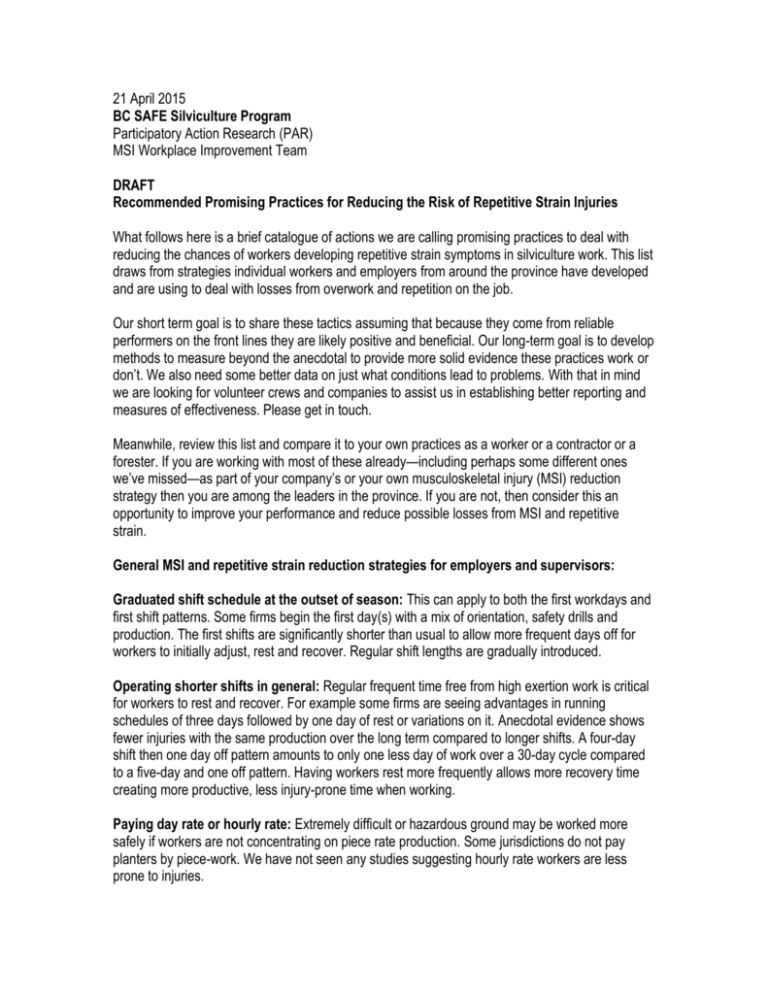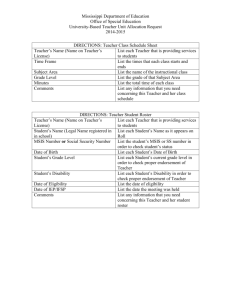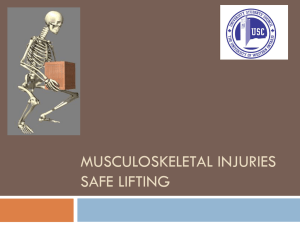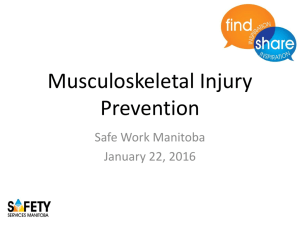MSI Promising Practices
advertisement

21 April 2015 BC SAFE Silviculture Program Participatory Action Research (PAR) MSI Workplace Improvement Team DRAFT Recommended Promising Practices for Reducing the Risk of Repetitive Strain Injuries What follows here is a brief catalogue of actions we are calling promising practices to deal with reducing the chances of workers developing repetitive strain symptoms in silviculture work. This list draws from strategies individual workers and employers from around the province have developed and are using to deal with losses from overwork and repetition on the job. Our short term goal is to share these tactics assuming that because they come from reliable performers on the front lines they are likely positive and beneficial. Our long-term goal is to develop methods to measure beyond the anecdotal to provide more solid evidence these practices work or don’t. We also need some better data on just what conditions lead to problems. With that in mind we are looking for volunteer crews and companies to assist us in establishing better reporting and measures of effectiveness. Please get in touch. Meanwhile, review this list and compare it to your own practices as a worker or a contractor or a forester. If you are working with most of these already—including perhaps some different ones we’ve missed—as part of your company’s or your own musculoskeletal injury (MSI) reduction strategy then you are among the leaders in the province. If you are not, then consider this an opportunity to improve your performance and reduce possible losses from MSI and repetitive strain. General MSI and repetitive strain reduction strategies for employers and supervisors: Graduated shift schedule at the outset of season: This can apply to both the first workdays and first shift patterns. Some firms begin the first day(s) with a mix of orientation, safety drills and production. The first shifts are significantly shorter than usual to allow more frequent days off for workers to initially adjust, rest and recover. Regular shift lengths are gradually introduced. Operating shorter shifts in general: Regular frequent time free from high exertion work is critical for workers to rest and recover. For example some firms are seeing advantages in running schedules of three days followed by one day of rest or variations on it. Anecdotal evidence shows fewer injuries with the same production over the long term compared to longer shifts. A four-day shift then one day off pattern amounts to only one less day of work over a 30-day cycle compared to a five-day and one off pattern. Having workers rest more frequently allows more recovery time creating more productive, less injury-prone time when working. Paying day rate or hourly rate: Extremely difficult or hazardous ground may be worked more safely if workers are not concentrating on piece rate production. Some jurisdictions do not pay planters by piece-work. We have not seen any studies suggesting hourly rate workers are less prone to injuries. Rotating tasks and light duty: An effective strategy in nursery settings where workers can, for instance, vary repetitive tasks by working at different stations on the lift line. Although light duty work may be scarce in planting settings, workers with obvious early signs of repetitive strain or over exertion should be assigned tasks other than the work that created the symptoms. Dedicated trainers: According to the BC Silviculture Workforce Initiative surveys worker respondents show 100% dissatisfaction regarding planting productivity training. This may or may not have anything to do with the number of firms now reporting they are hiring full-time trainers to instruct new workers for their first weeks on the job. Dedicated training likely means an increase in the success rate of trainees in terms of production, retention, and fewer injuries. It presents an opportunity to build skills and knowledge around techniques, like ambidextrous planting, and proper habits around fitness, hydration and nutrition. Ambidextrous planting: Progressive firms now teach trainees to plant ambidextrously. One-sided workers should be encouraged to retrain themselves to relieve musculoskeletal imbalance and its consequences in terms of strains, posture, and overexertion. Preseason training generally gets mixed reviews from employers as a result of a lack of enthusiasm for workers. Most workers it seems aren’t showing up fit in spite of their employers’ recommendations. Nevertheless wise employers will continue to provide workers with advice on how to arrive better prepared for work. It will at least signal that reducing the risk of these kinds of injuries is part of the company’s safety strategy and workplace culture. It may eventually become the case that if enough employers require pre-season preparation, and then follow through on the job with supporting strategies like those catalogued here, workers may see pre-season prep as in their own interest and a condition of employment. Better orientation of prospective hires: To ensure that applicants have a clear idea of what kind of work they are applying for some companies are making efforts to portray the work more realistically on their websites and with their recruiting strategies. This reduces the chances of hiring people expecting an extended bush party (which is how some companies seem to promote themselves). Bringing in fitness and physiotherapists for worker orientation: Companies now bring in experts at the beginning of the season to educate crews on fitness and health. In some cases therapists can assess workers for fitness and give advice on how to stay, or get, fit on the job. Better record keeping on MSIs: Companies are now noting and recording all MSI and repetitive strain incidents including close calls. With these data they can infer any larger patterns and conditions that may contribute to the injuries and benchmark the effectiveness of their reduction strategies. Ideally these insights will be shared with the larger community to improve practices overall. Eliminating false planning imperatives for production: Planting must work to biological imperatives. But often it may be the case that production goals and timelines set by forestry managers go more to addressing administrative convenience and the allocation of their own internal resources and time. Setting higher production rates than truly necessary biologically may have the effect of shortening the work period for workers leading them to press themselves to meet their own production expectation. This can lead to increased risk of injuries. It is likely that projects, and the whole season for that matter, could run a little longer so as to reduce the performance pressure on workers with little expense to seedlings. Eliminating unnecessary screefing: Screefing is hard on workers and should only be required where it is a proven fact that the extra effort improves performance and survival of seedlings. There is sound evidence that screefing, as is often done in parts of the province, may actually set back the performance on the seedlings, while at the same time harming workers and increasing the chance of MSIs. More strategic thought needs to be applied to screefing in terms of both seedling and worker performance and health. Addressing overweight boxes and seedlings: Any extra weight, particularly water, that workers have to pack when handling seedlings increases the risk of MSIs. In particular contractual agreements need to consider stock-handling remedies for when seed lots arrive on site saturated and well beyond what might be considered a “normal” weight. Efforts should be made to moderate the number of overweight boxes that leave the nursery gate. Contractors need to bid, especially on summer hot lifts, with piece rates reflecting the extra work involved in heavier seedlings fully charged with water. Front line tactics for workers: Stretching before, during and after work can have an all purpose effect on health and reducing injuries. The wrists and forearms are particularly vulnerable to repetitive strain. So flex and stretch your hands, wrists and forearms on the ride to work. Remember that warmth is critical to any prework exercises. Don’t stretch cold. http://selkirk.ca/sites/default/files/Faculty%20Research/Selkirk%20College%20Research%20Wrist %20Pamphlet.pdf Wearing forearm warmers can provide tendons and muscles with a better chance against the cold. They can help with circulation and flexibility so that the moving parts in your wrists and arms don’t suffer tears and irritation leading to inflammation. Athletic compression fabrics worn as a sleeve may also prevent problems by supporting circulation and underlying tissue in the wrists and forearms. Wearing this stuff after you have symptoms will not help. Eat, drink and be healthy in general by regularly replacing fluids and calories lost to exertion throughout the workday. Leaving your muscles and neurons without nourishment or water will increase your chances of injuries of all sorts. Maintaining right nutrition and hydration affects everything from movement to judgment. http://selkirk.ca/sites/default/files/Faculty%20Research/selkirk-college-faculty-research-deliaroberts-fit-for-planting.pdf Plant ambidextrously and gain the advantage of a more symmetrical distribution of wear and motion on your limbs and frame in general. The majority of over exertion and repetitive strain injuries have their root in the musculoskeletal imbalances created by working one-sidedly. Change it up by recognizing the first symptoms of inflammation and adjusting your equipment or technique before things get worse. Report your symptoms to your First Aid attendant. Don’t try to work through what could be the first stages of tendonitis. It will only get worse. The beginning of the season is when the risk is the greatest. But you can crap out mid-season too. Arrive fit and prepared for hard work. Take some time to follow the pre-season training advice you should be getting from your employer. Educate yourself on repetitive strain injuries and develop a plan to avoid them. Do the exercises so you won’t blindside yourself with how hard the work actually is. Continue the exercises and stretching at work to stay fit. Think of yourself as an industrial athlete. The big picture: limits of remuneration; maladaption and other elephants in the room briefly analyzed. The practical guidelines listed so far operate within a larger set of principles that may seem to be theoretical or abstract. Nevertheless these considerations very much influence what managers, owners or workers do, or are capable of doing, to reduce or increase the risks of MSIs. They look like this. In summary there are five general areas that better performing contractors and licensees are working in to reduce MSIs: 1. Pre-season training and worker-based activities. This includes education of workers and development of training programs to better prepare workers for their job, and assist them in understanding the nature of MSIs and basic management principles 2. Injury management systems (including Stay At Work (IMSAW), and Return To Work (IMRTW)). Included in this is proper adaptation of administrative systems, compliance with WSBC regulations, training of in-house staff to implement program, and SAFE Companies audit protocols for IMRTW. 3. 3A) Professional intervention/involvement in training workers and coaching good techniques and providing on-site assistance in managing MSIs. 3B) Proper training of workers in use of ergonomic techniques. This includes use of proper information resources as part of the actual training process, and use of information resources in retraining and evaluating workers by supervisors. 4. Client collaboration in managing challenging contract specifications that present MSI hazards to workers. This includes discussion of treatments for land, and adjustment of specifications in high-risk circumstances. 5. Engineering controls and equipment modifications. This includes manufactured and worker adapted changes to equipment, including bags, shovels, gloves, and other items. Looking at the situation through this summary there are a number of industry dynamics that stand to prohibit or promote improvement in reducing MSIs including: 1. Incentives and motivations to adapt specific initiatives, and to participate in specific programs/relationships. This includes incentives for workers to adapt, for companies to change practice, and for licensees to support change. Who, for instance, is offering incentives for planters to begin to develop ambidextrous planting techniques? 2. Worker culture and maladaptation. Front line response to new initiatives must be considered and analyzed. For example, do higher prices facilitate better or worse work habits? Do shorter seasons intensify work habits and MSI risks? What level of pay is appropriate/optimal for IMRTW alternative work programs? Are workers modifying equipment improperly? 3. Company culture and maladaptation. Do contractors see MSI strategies as a way to protect worker health, or solely as a method of increasing productivity? Are company administrative systems flexible enough to integrate significant changes to practice? Will gains in productivity through working more safely be lost to lower piece rate payment? Implementing and Assessing Change. These are broader high-level considerations that guide the ability of the industry to identify the “most bang for the buck”, and to encourage change among industry members. 1. Proper data collection is lacking. There is a lack of a clear standardized definition of MSIs. These vary from company to company, and individual to individual. There are varying definitions of MSIs in different administrative systems (and personal terms of reference) in terms of what level of symptom or injury results in which level of intervention. Clarity in this domain is desirable for enabling a wider and more consistent improvement in practice. Ideally, specific adaptations within the 5 areas of activity can be operationalized as variables that can in turn be analyzed in terms of their influence (ideally statistical influence as measured via linear regression) on MSI incidence rates. 2. Outreach modalities are needed for gathering and sharing information and techniques.





